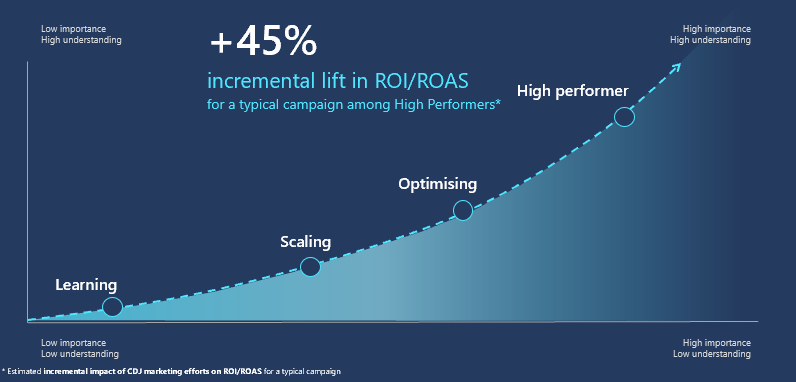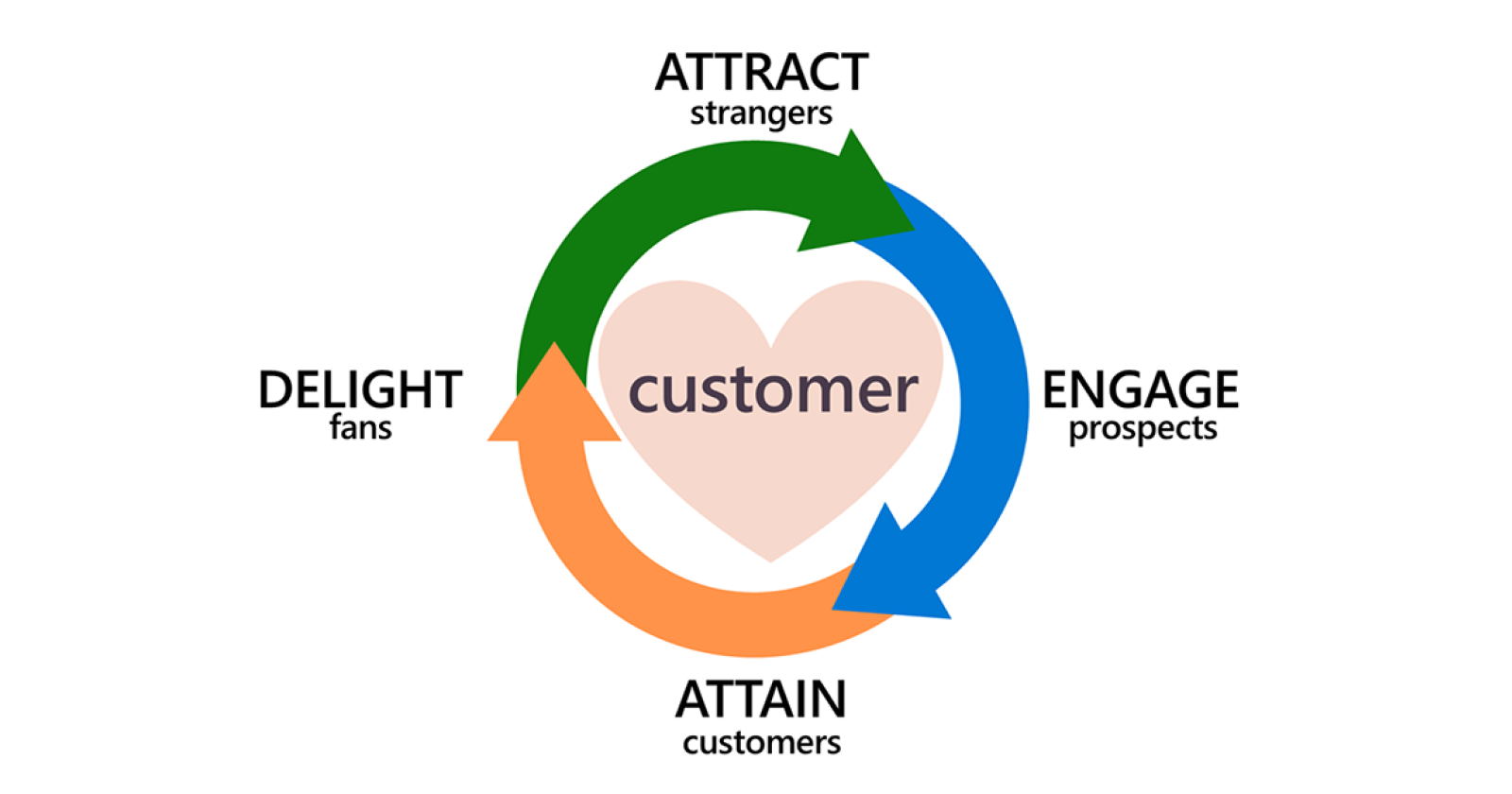Ever since the introduction of the AIDA model in the late 1800s, marketers have been focused on growing a traditional marketing funnel.
For over 100 years, the AIDA model was considered a marketing cornerstone as it moved consumers through a series of four linear stages in a purchase journey:
- Awareness.
- Interest.
- Desire.
- Action.
In turn, marketers have spent most of their time attracting large amounts of consumers at the top of the funnel, with only a small portion of consumers moving through to a final action, or purchase.
Put simply, within a marketing funnel, the majority of time and energy gets lost on prospects that do not convert.
But what if that energy wasn’t lost?
What if that energy could be redirected back into the purchase journey for real results?
And what if customer energy could be harnessed and added to the equation?
From Funnels to Flywheels
Throughout history, inventors such as James Watt and his steam engine have turned to flywheels for the superior way they store energy.
Now marketers are doing the same.
Marketers are turning to energy-efficient flywheels to leverage data from across the customer decision journey and grow their brands in the digital era.
What makes flywheels superior?
As long as there are no forces working against them, flywheels continue to spin faster and faster, and require less energy to keep going once they start.
In the same way, today’s marketers are leveraging all of the data they have access to in order to:
- Make their marketing more effective (think remarketing).
- Create data-driven touchpoints (including chatbots, digital assistants and other intelligent agents) that help to build momentum and further engage customers to boost revenue and ROI.
And it’s working.
Internal Microsoft Advertising research on creating smarter customer journeys has found that the top performing marketing who leverage data to create more meaningful touchpoints can see up to a 45% incremental lift in ROI/ROAS.
Why now?
What is causing the flywheel disruption and how can marketers make the most of it?
Here are three factors driving the shift and what you can do to take that insight into your search campaigns today.
1. Customer-Centricity
We are moving from a very product-centric world to a customer-centric world; it’s occurring across all markets and verticals.
In today’s world, simply having customers is not enough. There is a new category of customer in the digital age: the fan.
Today’s businesses need to create brand love that incubates fans that will evangelize their brand.
While funnels produce customers, they don’t address customer health or how customers can help grow your business or drive engagement with future customers.
Happy customers, or brand fans, propel flywheels through word of mouth, customer feedback and repeat purchases.
Unlike linear funnels that end with a sale, flywheels create a self-sustaining virtuous cycle of four stages:
- Attracting strangers.
- Engaging prospects.
- Attaining customers.
- Delighting fans.
The customer is at the heart of the flywheel.
Making It Real for You
Start Documenting Your Customer Journey
First, start documenting your customer journey so you can put your customer at the heart of everything you do. It sounds simple, right?
In our internal research, we found is that 80% of marketers and agencies from our survey are struggling to use AI technologies to better understand their customer decision journey and increase their marketing performance.
As customer decision journeys get more complex – and less linear – it’s essential to use the technologies to better understand and engage your customers.
The 20% of high performers more deeply understand the consumer decision journey and, as a result, can better predict consumer behavior and intent.

Is Your Attribution Model Hurting or Hindering Your Ability to Be Customer-Centric?
Second, ask yourself: Is your attribution model hurting or hindering your ability to be customer-centric and how your programs engage with your customers?
Simplistic attribution models were better suited to the simplicity of channels for marketing and sales in the early 1900s.
However, due to the increasing complexity of customer engagement with devices and channels that have exploded in the last 20 years, marketers need to evolve their attribution model.
The marketing flywheel lends itself to Lifetime Customer Value.
2. Search & Social
The AIDA funnel was a very long-lived and successful marketing tool – but that was before the internet, long before search or social sharing hit the scene.
Search engines and social media have completely changed how we work, shop and live.
Customers used to go directly to a customer service organization for information and assistance with products and services. But this is no longer the case.
Now, customers first go directly to the search engine for answers/content.
If they can’t find what they are looking for on page 1 (maybe page 2 of the search results if you are lucky) they then turn to social platforms such as Facebook and Twitter.
After that, if they can’t get an answer they may try to go the route of contacting a customer service department.
Customers are more empowered than ever before and play an important role as trusted sources of information. But that doesn’t mean that brands and companies are off the hook.
It means that now more than ever you need to take back your truth and make sure that you have the answers to the questions that strangers, prospects, and even your customers are asking.
Don’t let a Munion speak half-truths on your behalf.
Making It Real
Make sure your customers can find what they are looking for right away.
Do your research to understand what your customers are asking (not just what you think they are asking) and take back and own the conversation.
3. Data & AI
Data is the renewable energy of the next century. This new world order makes it essential for companies to optimize their customer experience (CX) for the right engagement channels including:
- Search.
- Social media.
- Mobile.
- And even some of the newer technologies including:
- Digital assistants.
- Chatbots.
- VR/AR.
Data-driven touchpoints are the key to the modern CX as they spin your flywheel and grow your business. These touchpoints have two goals:
- To delight customers.
- To gather more data to help personalize future touchpoints.
They are also how you apply force to your flywheel as you leverage AI (artificial intelligence) and ML (machine learning) to continuously optimize the experience.
Own and unlock your data! From our internal research, the top performing marketers are using ML to make AI systems smarter with every interaction.
Unlocking your data at scale is key for creating personalized and interactive brand experiences that are infused with cognitive services and AI technologies such as chatbots, voice skills, and digital assistants.
They’re applying ML to anticipate behaviors and consumer actions to attract, engage, attain, and delight customers. They’re creating smarter, more tailored experiences at key points along the customer decision journey.
What’s the benefit of unlocking your data?
The top performers with an excellent data and AI strategy and are seeing amazing results – 45% incremental lift in ROI/ROAS.
Making It Actionable
Own your data to create audience segments – and use those audiences segments in your paid search accounts to move customers along their journey.
Customize your ad copy and landing pages based on the audience segments you’ve identified from your data and insights into the customer journey.
Reduce Friction
After creating a flywheel, the next big question becomes how to reduce friction.
Friction kills flywheels, and companies can often work against themselves.
Essentially, companies should rethink anything that prevents them from focusing on the customer.
| Friction Points | Solution |
| Disjointed Teams | Work together across all channels as a singular marketing team |
| Siloed Processes | Create cohesion across all of your customer touchpoints to present a unified front to customers |
| Data Loss | Make sure you have a system to capture data and optimize a singular customer across their journey |
| Customer Churn | Stay close to your customers with surveys, reviews and social media to identify and mitigate issues |
| Prospects | Quickly change prospects into customers with high-value, actionable touchpoints |
Making It Real
Look at both your organic search and your paid search data to identify friction points.
The friction points in paid search may be identified with a poor quality score – this means that your keywords, ad copy, and landing pages aren’t necessarily aligned. There is a mismatch in the message and the content.
The New Customer Decision Journey
The customer journey is undergoing exponential change as new technologies shift power to the customer.
Modern customers share.
They inform.
They review.
They ‘like.’
Marketers must adapt to stay relevant and trade their outdated funnels for more inclusive flywheels. When done right, flywheels can quickly transform strangers into brand fans.
The speed increases as you grow and focus on adding force (the programs and channels you use to drive it) and energy (the touchpoints and data that’s fueling it).
And unlike the funnel which ends with a sale, a happy customer marks just the beginning.
More Resources:
- The Marketing Funnel Isn’t Dead, We Just Understand It Better
- When Optimizing Your PPC Campaigns Strangles The Funnel
- 12 New Realities of Inbound Marketing
Image Credits
Featured & In-Post Images: Microsoft Advertising





